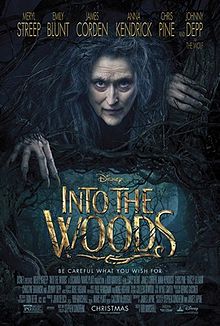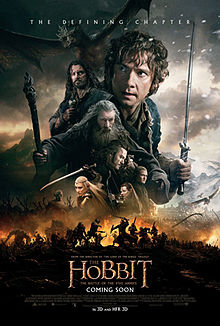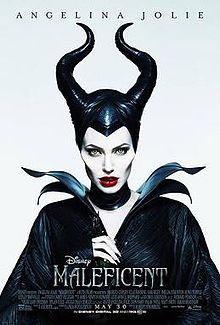Fantasy films - 2014
| Into the Woods | The Hobbit: The Battle of the Five Armies | Maleficent |
____________________
 |
Rumors that Rob Marshall’s Into the Woods would depart drastically from its fantastic source material have been greatly exaggerated. Although the movie is produced by Disney and does feature a few significant changes, most of the darkness and complexity of Stephen Sondheim’s original musical is retained. The result is a film in two acts, the first of which presents four classic fairytales (Cinderella, Little Red Riding Hood, Jack and the Beanstalk, Rapunzel) in which wishes are granted and “all who deserve to live happily ever after, do.” While this first act is certainly magical and fun, the stories are nothing we haven’t seen before. What’s really interesting about Into the Woods is its second, darker act, which examines a familiar idea less commonly found in fairytales: “Be careful what you wish for.”
As recent Broadway-to-Hollywood adaptations go, Into the Woods is definitely one of the most successful. Although the film employs a star-studded cast, it avoids the common pitfall of sacrificing vocal talent for name recognition. Unsurprisingly, Pitch Perfect star Anna Kendrick is a particular standout as Cinderella, carrying off the soprano part beautifully. The instrumental music is also impressive, and the visual effects create an appropriately magical atmosphere.
That said, total purists might be frustrated by a few changes, including the absence of the narrator as a character and the exclusion of a few of the songs. While all of the major staples are there, including “Children Will Listen,” “Agony,” and “Giants in the Sky,” a few gems are missing. It might be for this reason that the first act seems to lack some necessary character development. Specifically, the song “It Takes Two,” in which the Baker’s Wife (Emily Blunt, The Edge of Tomorrow, Looper) rhapsodizes over the way that their adventure has changed her husband (James Corden), seems completely unearned. Perhaps the inclusion of some of the cut dialogue and songs, including “Maybe They’re Magic,” with the golden pun, “If the end is right, it justifies the beans,” might have helped.
However, given a few weaknesses in the script, most of the performances are excellent. Emily Blunt plays the Baker’s wife with spirit and determination, and Chris Pine (Star Trek, Jack Ryan: Shadow Recruit) and Billy Magnussen expertly chew up the scenery as dueling narcissists in “Agony.” Pine in particular provides many of the film’s laugh out loud moments. If the cast has a weakness, it might be Johnny Depp as the menacing Big Bad Wolf. Although the actor does a fine job, his over-saturation in Tim Burton films makes his fedora-wearing, mustachioed wolf seem almost like a transplant from a different, more cartoonish film.
Overall, Into the Woods makes a strong showing. Helmed by the director of the massively successful Chicago, it makes an excellent addition to the canon of movie musicals. Quality vocals and performances, beautiful instrumentation, and enchanting visual effects make it an entertaining diversion, which for the most part, remains faithful to the original musical—even if a few cuts leave it feeling occasionally underdeveloped. Fans of musicals and fairytales alike should be pleased with this Christmas release.
- Kathryn Carty
____________________
 |
“Will you stand with me… one last time?” a voiceover asks in the trailer to The Hobbit: Battle of the Five Armies. These words might just as well be a plea from Peter Jackson to his fans as they are a call to battle from Thorin Oakenshield to his followers. Unfortunately, however, the capstone to the Hobbit trilogy fails to live up to the expectations set by a strong second film, reminding us once again that such a short book did not need to be made into a full trilogy.
The film begins in medias res, immediately getting off to a fast pace, so it may be wise to brush up on the last movie before hitting the theaters. Without a strong recollection of where we left off, viewers will likely be lost in the sea of fire and chaos occurring onscreen. However, all this action is isolated to a mere teaser spot before the opening credits. Over the course of these first few minutes, a climactic battle has been fought, and most of the perilous loose ends left to us by The Desolation of Smaug have been tied up, all before the title even appears onscreen.
Where does this leave us for the rest of the movie? After the first vignette—in which we see most of the real desolation wrought by Smaug—the rest of the film centers on the titular battle—where elves, dwarves, and men struggle to hold a fortified stronghold against an army of invading orcs. While this may sound exciting, it’s nothing we haven’t seen before, at length, in the original Lord of the Rings trilogy. Additionally, our heroes face corruption by sinister golden artifacts that engender debilitating greed and selfishness, making their task all the more difficult. Sound familiar?
If there is anything that distinguishes the fighting in this film from previous movies, it is the absurd body count racked up by our heroes. While in The Two Towers, Gimli (John Rhys-Davies) and Legolas (Orlando Bloom) amusingly keep a tally of all the enemies they’ve killed, coming to a final count of 43 for Gimli and 42 for Legolas, the characters in The Battle of the Five Armies achieve even more preposterous feats. When four dwarves are confronted with “no more than a hundred” goblin mercenaries, half the party nonchalantly agrees to “handle them” while the two others forge on ahead. Never mind that these are the same dwarves easily captured by three trolls in the first movie and subsequently recaptured by a band of goblins, only to need rescuing from Bilbo Baggins (Martin Freeman).
The only character who seems to have been powered down for this movie is Tauriel (Evangeline Lily), the elf created by Jackson expressly for these movies. Although in the previous film, Legolas and Tauriel seem well-matched in deadliness, The Battle of Five Armies sees Legolas remaining implausibly unstoppable, while Tauriel becomes useless for much of anything except creating opportunities for our (male) heroes to rescue her. This became tiresome very quickly, although the battle scenes are admittedly well-choreographed and at times, enjoyable to watch. As in the last movie, Legolas is a standout.
Ultimately, this film is just okay. While it includes far more action than the first movie, it is very one-note compared to the second. The overall result is a movie you might be content to rent on Netflix if it weren’t for one thing: the whole series is just so pretty. As in all of Jackson’s Tolkien movies, you can expect to be immersed in a beautiful, believable Middle Earth—an effect that isn’t as easily accomplished on a small screen. So, if you became invested in the characters during the first two movies, if you enjoy a good epic battle, or if you’re just a die-hard fan of the series, you’ll definitely want to see this one in theaters. You will see a great deal of orc slaying, the resolution to the Kili-Tauriel-Legolas love triangle, and enjoy Martin Freeman’s charming Bilbo Baggins. Additionally, fans are practically guaranteed to enjoy the final few minutes of the film. However, if you were lukewarm on this series to begin with, this installment is not going to change your mind. Wait for it on DVD instead.
- Kathryn Carty
____________________
 |
I wasn’t expecting to like Maleficent. Disney doesn’t have a great track record with live action adaptations of its animated classics. Its 1994 Jungle Book film, its 1996 101 Dalmatians reboot, and its 2000 sequel, 102 Dalmatians, all met lukewarm receptions at the box office. Even worse, 2009’s Alice in Wonderland (http://www.rottentomatoes.com/m/1221547-alice_in_wonderland/) somehow managed to be both visually stunning and hopelessly dull—another nail in the coffin of public patience for the Tim Burton, Johnny Depp, and Helena Bonham Carter trio. So, when I first saw previews for Maleficent, I couldn’t help rolling my eyes. Here would be another overproduced special effects explosion, an uninspiring star vehicle for Angelina Jolie that would capitalize on the popularity of an iconic Disney villain and the recent public fascination with antiheroes, but ultimately deliver nothing terribly interesting or original.
Therefore, I was pleasantly surprised to find that in addition to the beautiful effects that I had anticipated, Maleficent actually offers us an intriguing story. Beginning years before conventional heroine Sleeping Beauty is born, the film provides a backstory that renders its title character genuinely sympathetic. While this origin story does require its audience to suspend disbelief during a few unlikely events, the result is a three-dimensional antihero who, while deeply wronged, comes to regret her righteous vengeance. The story plays well on the popular lesson that, once released, a curse can never be revoked. For her part, Jolie delivers a magnetic performance, both convincingly powerful and reluctantly tender.
That said, the film is not without its flaws. Although Maleficent provides wonderful life and detail to its title character, some of the supporting performances fall rather flat. Sharlto Copley is acceptable, but somewhat two-dimensional as King Stefan. Additionally, the script doesn’t give Brenton Thwaites’ Prince Philip much to do. A perfectly nice but ultimately irrelevant young man, he wanders haplessly and ineffectually on and off the screen with little to no effect on the story. While the intention is clearly to focus our attention on the relationship between Jolie’s Maleficent and Elle Fanning’s Princess Aurora (a feminist move in keeping with the trend established by 2013’s Frozen), it does render the character a bit out of place, like an extra lost on his way to the set of Glee. While this did have a comic effect, in the future, it would be gratifying to see Disney produce a fairy tale that simultaneously provides us with strong, dynamic heroines and complex, relevant heroes. Although the breaking of the traditional active hero/passive heroine mold for Disney stories has been long overdue, it would be disappointing to replace it with a new, equally formulaic narrative in which male characters are all predictably evil or irrelevant.
Finally, I would be amiss if I did not include a nod to the supporting characters, Sam Riley’s Diaval the crow and the three good fairies, played by Imelda Staunton, Juno Temple, and Lesley Manville. Riley does an excellent job as a likeable henchman and conscience for Maleficent. The character also provides a wonderfully versatile familiar for the wicked fairy, transforming from a bird to a man, a wolf, a horse, and finally a fantastically menacing dragon. Unfortunately, the fairies are not nearly as interesting or easy to like. Although clearly intended to provide comic relief as lovably bumbling guardians to Princess Aurora, their incompetence strained credulity. In addition to lacking the most basic childcare skills, the trio seem completely apathetic to the princess’s whereabouts throughout the film, as if somehow forgetting the dire curse they’re supposed to be protecting her from. Popping up only as an occasional annoyance, they are even oblivious to the fact that teenaged Aurora eventually appears to spend most of her afternoons hanging out with Maleficent in the woods near their house.
However, in spite of my harsh words about the fairies, I enjoyed this film quite a lot. While some of the supporting roles were a bit disappointing and the soundtrack was occasionally a bit loud and obtrusive, this rendition of the Sleeping Beauty story does for the original what Wicked did for The Wizard of Oz. I left the theater actually looking forward to the next live action Disney movie, a Cinderella remake set for release in 2015. Intriguingly, the studio seems to be wrangling directors from the Marvel Cinematic Universe for their upcoming efforts, with Cinderella to be directed by Kenneth Branagh (Thor) and an October 2015 Jungle Book to be directed by Jon Favreau (Iron Man). (Source: http://screenrant.com/disney-animated-live-action-movies/)
- Kathryn Carty